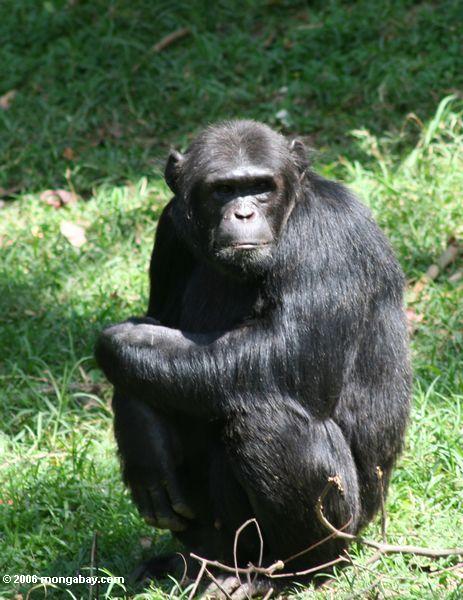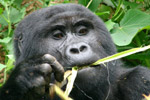Ugandan forest managers stress the importance of public support and participation in conservation efforts
Stung by massive loss of forest cover in Bugoma central forest reserve, part of a vast chimpanzee habitat in the western part of Uganda, seven private local and international organizations in the east African country have joined hands to raise awareness of forest issues and money for reforestation efforts — by launching a conservation-themed quarter-marathon.
The maiden 10-kilometer run (with a five-kilometer option for those who’d rather run a bit less) is named ‘”Run for Nature” and will take place on September 7, 2014. Organizers say they expect to raise at least 20 million Uganda shillings (about $7,800) from participation fees.

Bugoma Forest Reserve (circled) is bordered by intense deforestation. Between 2001-2013, some areas immediately surrounding the reserve lost upwards of 50 percent of their forest cover, according to data from Global Forest Watch. Map courtesy of Global Forest Watch. Click to enlarge.
Constantino Tessarin, the coordinator of the Bugoma forest conservation campaign, said the proceeds from the run will be invested in “the first reforestation exercise of Bugoma central forest reserve after many years in which no such exercise took place.”
“We intend to invest in reforesting degraded areas by planting indigenous trees and important species which are so much needed in the ecosystem to sustain the chimpanzee population and other animals,” he said.
At a press conference in Kampala about the event, Tessarin said the idea was born in February, after a public lecture at Kyambogo University in Kampala that revealed the extent of the degradation, illegal logging and deforestation taking place in Bugoma forest.
“We decided to work together to take action against all this destruction and because we feel that the private sector and the civil society can play a vital role in helping forest conservation,” he said. “Bugoma forest conservation campaign decided to make steps in different directions: promoting awareness about forest conservation with public events; working on research and preparation of a long term conservation project for the forest and the surrounding communities; planning eco-tourism development to improve on conservation and job creation in the area.”
 Bugoma Forest Reserve provides important habitat for eastern chimpanzees (Pan troglodytes schweinfurthii), which are currently listed as Endangered by the IUCN. Photo by Rhett A. Butler. |
Tessarin said the 2014 run will be the first of what they expect to be an annual event. They hope to tempt participation with prizes, including a holiday package at a local lodge and a game drive at Murchison Falls National Park.
Organizers of the run, which has been endorsed by National Forestry Authority (NFA) of Uganda, include the Kyambogo University Environmental Management Association (KUEMA), Uganda Wildlife Society, Chimpanzee Sanctuary and Wildlife Trust, Green Bio Energy Ltd, Destination Jungle Ltd, and Green Organisation Africa Ltd.
Bugoma forest, which comprises 41,144 hectares, is ranked 12th out of 65 central forest reserves considered to be of biodiversity importance in Uganda. Located in western Uganda’s wildlife migratory corridor that also includes the River Kafu basin, Bugoma has 267 species of trees, 18 mammals, 278 butterflies and 221 bird species.
Of the mammals in the forest, according to NFA, primates are most abundant, with an estimated chimpanzee population of 580. It also has a large number of black and white colobus (Colobus species), Ugandan mangabey (Lophocebus ugandae), red-tailed monkeys (Cercophithecus ascanius), blue monkeys (Cercopithecus mitis), as well as a small population of bush elephants (Loxodonta africana), golden cats (Profelis aurata) and side-striped jackals (Canis adustus).
Data from Global Forest Watch shows that between January 2001 and December 2012, a 62,254-hectare area that contains Bugoma forest lost 5,747 hectares of forest cover – in other words, the region around lost about nine percent of its tree cover in just 12 years. Some areas directly bordering the reserve have lost upwards of half their forest cover. Nationally, Uganda lost approximately 365,000 hectares of forest over this time, representing 1.5 percent of its total land area.

The Kafu River begins immediately east of Bugoma Forest Reserve, and has experienced massive deforestation due in large part to agricultural clearing. Of the approximately 90,000-hectare area of the upper Kafu River basin, more than 17,000 hectares of forest were lost between 2001 and 2013, according to data from Global Forest watch, and some portions of Kafu’s riverbanks have lost almost all of their forest cover. Map courtesy of Global Forest Watch. Click to enlarge.
Presenting the findings of a survey they carried out in April, Laster-Stoney Ogola, a project officer with Uganda Wildlife Society, said the major causes of the massive deforestation in Bugoma forest include limited community awareness of their role in forest management and conservation, and insufficient funding for forest patrolmen. Others include failure by forest authorities to tame illegal forest activities such as logging and poaching, and conflicts between forest managers and communities regarding resource ownership and benefits.
“The government and, in particular Bugoma forest managers, need to address these factors to be able to enhance community participation in the forest management and conservation,” he said.
The 40 respondents to the survey recommended five actions that need to be implemented in order to conserve the forest. They included increasing the human resource capacity charged with the management of the forest, sensitizing communities about their roles in forest management and protection, restoring degraded parts of the forest by planting indigenous tree species and putting up clear forest boundary markings.
According to Ogola, the respondents also called on the government and forest conservation enthusiasts to “provide benefits to communities, including establishing socio-economic, ecologically beneficial conservation enterprises such as ecotourism, tree seedlings for on-farm planting, small businesses and others, to encourage their participation in forest management and protection.”
The Spokesperson for NFA, Gilbert Kadilo, said Bugoma forest “has come under immense pressure” from encroachers. He said the agency does not have the capacity to monitor, on its own, activities in all of the 506 central forest reserves under its care.
“The job of managing these resources is no small job. There are immense challenges that we face,” he said. “We should not leave these things to the government. Much as we say the management of NFA is investing in forest conservation, the role of the wider public cannot be over-emphasized.”
}}
Related articles
The last best place no more: massive deforestation destroying prime chimp habitat in Uganda

(07/09/2014) The Kafu River, which is about 180 kilometers (110 miles) long, is part of a vast chimpanzee habitat that includes forest reserves and several unofficial protected areas. However, this region of Uganda is losing a significant portion of valuable chimpanzee habitat, and at least 20 percent of the forest cover along the Kafu River has disappeared since 2001.
Next big idea in forest conservation? The ‘double-edged sword’ of democracy

(07/03/2014) Dr. Douglas Sheil considers himself an ecologist, but his research includes both conservation and management of tropical forests. Currently teaching at the Norwegian University of Life Sciences (NMBU) Sheil has authored and co-authored over 200 publications including scholarly articles, books, and popular articles on the subject.
Tipping the scale: how a political economist could save the world’s forests

(05/29/2014) Can Elinor Ostrom’s revolutionary ideas halt climate change, improve people’s livelihoods, and save the world’s forests? The Nobel-prize winning economist famously said, ‘There’s a five-letter word I’d like to repeat and repeat and repeat: Trust.’ Mongabay Special Reporting Initiative Fellow Wendee Nicole reports on Ostrom’s innovative ideas of global forest conservation.
Deutsche Bank dumps controversial palm oil company
(05/27/2014) Deutsche Bank has sold its stake in Bumitama, an Indonesian palm company that has been embroiled in controversy over alleged destruction of rainforests and peatlands in Borneo, reports Friends of the Earth Europe.
Seeing the Forest for the Trees: How ‘One Health’ Connects Humans, Animals, and Ecosystems

(05/05/2014) The emerging One Health movement recognizes the inextricable connections between human, animal, and ecosystem health and is leading not only to new scientific research but also to projects that help people rise out of poverty, improve their health, reduce conflicts with wildlife, and preserve ecosystems. Mongabay.org SRI Fellow Wendee Nicole reports.
Primary school children build fuel-efficient stoves in Uganda

(01/10/2014) A group of young children have become a catalyst in the effort to save Kibale National Park from deforestation. Children from Iruhuura Primary School in Uganda have collaborated with the Kasiisi Project and Camp Uganda to build fuel-efficient stoves, developing a more sustainable method of wood consumption around the hugely-biodiverse Kibale National Park.
Sky islands: exploring East Africa’s last frontier
,-South-Pare-Mts.-Tanzania.150.jpg)
(12/04/2013) The montane rainforests of East Africa are little-known to the global public. The Amazon and Congo loom much larger in our minds, while the savannas of East Africa remain the iconic ecosystems for the region. However these ancient, biodiverse forests—sitting on the tops of mountains rising from the African savanna—are home to some remarkable species, many found only in a single forest. A team of international scientists—Michele Menegon, Fabio Pupin, and Simon Loader—have made it their mission to document the little-known reptiles and amphibians in these so-called sky islands, many of which are highly imperiled.
New children’s book celebrates the rich wildlife of Kibale National Park

(11/25/2013) There are many ways in which people practice conservation. The most well-known are working to save species in the field or setting up protected areas. But just as important—arguably more important for long-term conservation success—is conservation education, especially with children. Anyone who grew up watching David Attenborough documentaries, reading Gerald Durrell books, or simply exploring ecosystems on their own can tell you how important it is to encounter the wonders of wildlife at a young age. And for many of us most of our first encounters with wild animals are in illustrated books. Eric Losh’s new book, The Chorus of Kibale, not only provides an educational opportunity for children to become acquainted with the many animals in Kibale National park in Uganda—through wonderful pictures and sounds—but proceed also go directly to two conservation groups working in the region, U.N.I.T.E. for the environment and the Primate Education Network (PEN).